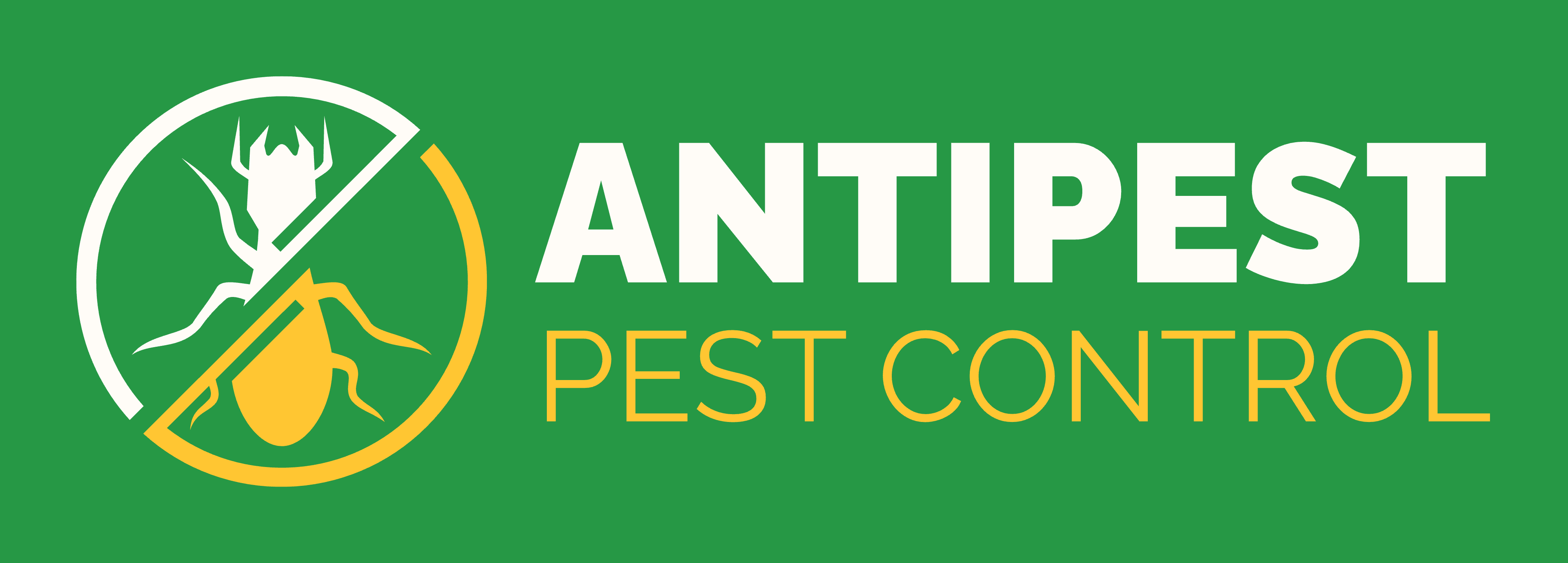Learning how to get rid of wood eating insects is critical for protecting homes, furniture, and valuables, from cherished antiques to hardwood floors, from costly damage and safety risks. Signs like powdery frass, mud tubes, or hollow-sounding beams can appear before structural failure, so knowing how to get rid of wood eating insects early makes a real difference. For many households, the choice between DIY steps and licensed services hinges on scope; moisture control, borate treatments, and careful monitoring are core to how to get rid of wood eating insects efficiently.
With clear identification, targeted methods, and prevention habits, it becomes practical to decide how to get rid of wood eating insects without overspending or overlooking hidden trouble spots.
Table of Contents
What are Wood Eating Insects?
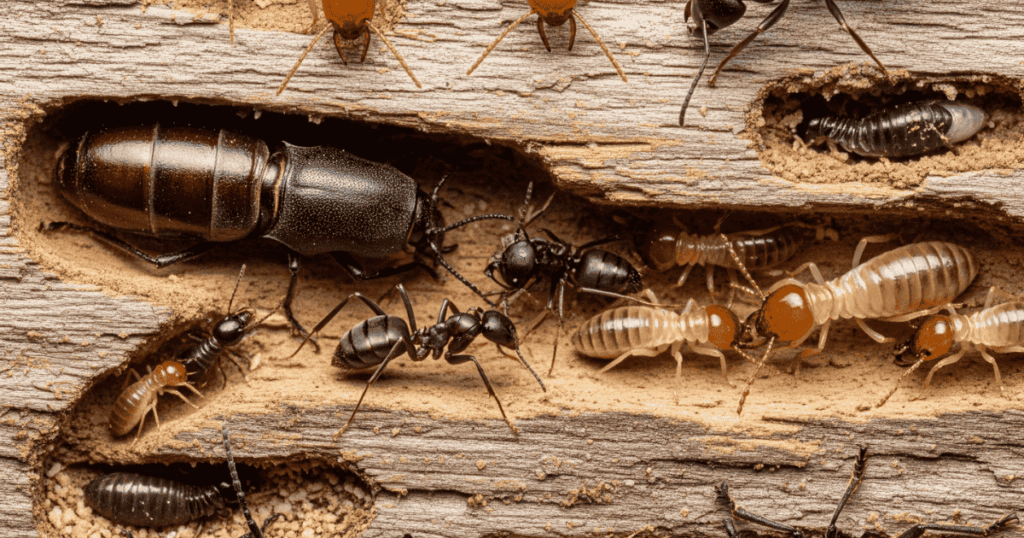
Recognizing wood eating insects and their destructive habits is the first step to safeguarding your property. These pests come in many forms and can have varying degrees of impact depending on their biology and feeding behaviors.
Major Types of Wood Eating Insects
Many insects destroy wood, but only a few are notorious for causing property damage:
- Termites: The most damaging, capable of swiftly undermining homes.
- Carpenter ants: Excavate wood for nests, often targeting damp or decaying areas.
- Carpenter bees: Drill holes in wood for their larvae, weakening structures.
- Wood-boring beetles: Includes powderpost beetles, old house borers, and deathwatch beetles, all damaging, especially as larvae.
- Wood mites: Mainly feed on mold but may accelerate wood decay.
Comparative Table: Types of Wood Eating Insects
| Insect | Common Signs | Preferred Wood | Activity Season | Damage Pattern |
| Termites | Mud tubes, hollow wood | Soft/damp wood | Spring–Summer | Internal tunnels |
| Carpenter Ants | Sawdust (frass), large ants | Moist/decayed wood | Late Spring–Summer | Smooth galleries |
| Carpenter Bees | Round entry holes | Unpainted wood | Spring–Early Summer | Tunnels near surface |
| Powderpost Beetles | Fine powder, tiny holes | Hardwood | Year-round | Small boreholes, powder |
| Deathwatch Beetles | Clicking sounds | Softwood, old timber | Late Spring | Deep tunnels |
| Old House Borers | Oval exit holes, frass | Pine, softwood | Late Spring–Summer | Internal damage, oval holes |
| Wood Mites | Visible mites, dust | Damp wood | Humid periods | Surface erosion |
Detecting Wood Eating Insect Infestations
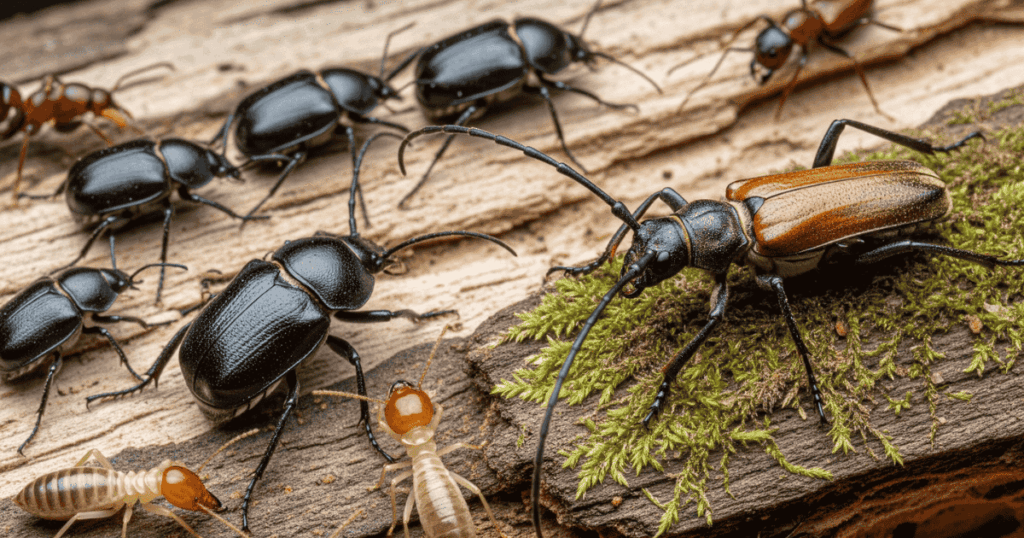
Early detection is vital to curb damage. Learn how to spot telltale signs of infestation and identify the culprit before substantial wood is lost.
Common Signs of Infestation
- Exit holes: Small round or oval holes where adults emerge.
- Saw dust or frass: Powder-like material under or near infested wood.
- Hollow wood: Knock on timber, if it sounds hollow, investigate.
- Tunnels: Visible lines or galleries within wooden surfaces.
- Cracks filled with eggs: Inspect cracks under torchlight for larvae or eggs.
- Discoloration or blistering: Damaged, stained, or blistered wood, often due to insect feeding.
- Clicking or rustling noises: Insects sometimes make faint noises as they burrow.
Signs and Their Likely Causes
| Sign | Insect Likely Responsible | Diagnostic Action |
| Fine sawdust | Carpenter ants/beetles | Check for frass and galleries |
| Round holes | Carpenter bees, powderpost beetles | Inspect for larvae and adult insects |
| Wood tunnels | Termites, old house borers | Probe wood depth |
| Hollow sound | Termites, deathwatch beetles | Tap with a mallet |
| Clicking noises | Deathwatch beetles | Listen during quiet nights |
| Wood dust/powder | Powderpost beetles | Sweep beneath infested item |
Step-by-step plan: How to Get Rid of Wood Eating Insects?
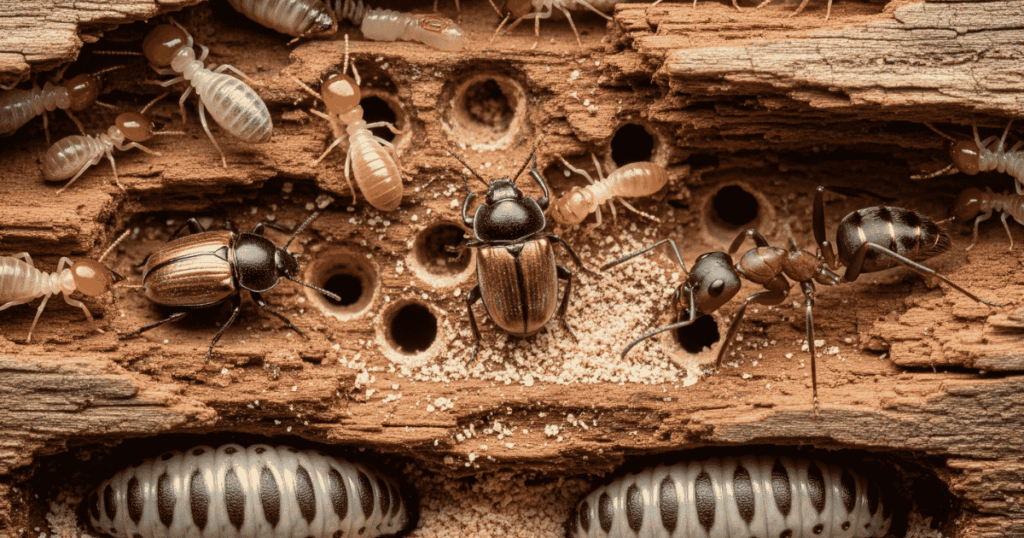
A clear sequence prevents missed steps and wasted effort. Follow this order for best results across homes and small businesses, and keep how to get rid of wood eating insects front and center at every stage for consistent results.
Step 1.Identify the pest
Match frass texture, hole size, and signs; if uncertain, collect samples and photograph damage. Correct ID is the backbone of how to get rid of wood eating insects effectively.
Step 2.Stabilize the environment
Reduce moisture, ventilate, fix leaks, and improve drainage; damp wood invites repeated attacks and undermines how to get rid of wood eating insects long term.
Step 3.Triage items
Prioritize structural elements; isolate or remove heavily infested, non-structural pieces; avoid moving infested items room-to-room to support how to get rid of wood eating insects efficiently.
Step 4.Treat accurately
Choose methods that match pests and items, borates for bare wood, heat/freezing for small objects, and professional injection or fumigation for widespread or hidden activity; this precision is central to how to get rid of wood eating insects.
Step 5. Seal and protect
Fill holes, apply finishes to bare wood, and seal cracks and checks that invite egg-laying; sealing helps lock in gains when working on how to get rid of wood eating insects.
Step 6.Monitor
Set monthly or seasonal checks for frass, exit holes, and beetles near windows; log findings and adjust, ongoing monitoring completes how to get rid of wood eating insects successfully.
How to Get Rid of Wood Eating Insects: Effective Methods
There are multiple avenues available for how to get rid of wood eating insects: mechanical, chemical, environmental, and preventive solutions. Tailor the method to the species and severity of the infestation.
Mechanical Removal Techniques
Manual methods can be effective for isolated infestations:
- Burn or discard infested wood: Destroy severely damaged timber to remove larvae and eggs.
- Vacuum and steam clean: Remove surface pests and frass using powerful vacuums and high-heat steamers.
- Inject treatments: Drill into affected wood and inject insecticide or natural repellent directly.
Chemical Treatments and Professional Solutions
Targeted chemical treatment is often the most direct method for how to get rid of wood eating insects:
- Borate-based wood treatments: Apply liquid or powder borate to unfinished wood, which penetrates and kills active pests.
- Fumigation: Seal the affected area and apply a gaseous insecticide to kill insects at all life stages; ideal for termites and beetles.
- Injection treatments: Use syringes to inject certified chemicals into visible galleries and tunnels.
- Sealing: Seal treated wood with pesticide-infused products to prevent future entry.
- Commercial insecticides: Use as directed for powderpost beetles, ants, mites, and others.
Natural Home Remedies and DIY Remedies
For those seeking less toxic alternatives for how to get rid of wood eating insects:
- Essential oil sprays: Tea tree, peppermint, and eucalyptus oils repel many insect species; mix with water and spray.
- Apple cider vinegar and borax: Acts as a natural insecticide against wood mites and other pests; combine and spray regularly.
- Dehumidification: Lower indoor humidity to discourage termites, beetles, and mites.
Treatment Options and Suitability
| Treatment Type | Pest Targeted | DIY/Professional | Effectiveness | Duration |
| Borate-based treatment | Beetles, termites | Both | High | Long-term |
| Fumigation | Beetles, all | Professional | Very high | Immediate |
| Essential oils | Mites, ants, bees | DIY | Moderate | Short-term |
| Injection chemistry | Beetles, termites | Professional | High | Long-term |
| Dehumidification | Termites, mites | DIY | Supportive | Ongoing |
| Apple cider vinegar | Mites, minor pests | DIY | Moderate | Short-term |
Prevention: Protecting Wood from Future Infestations
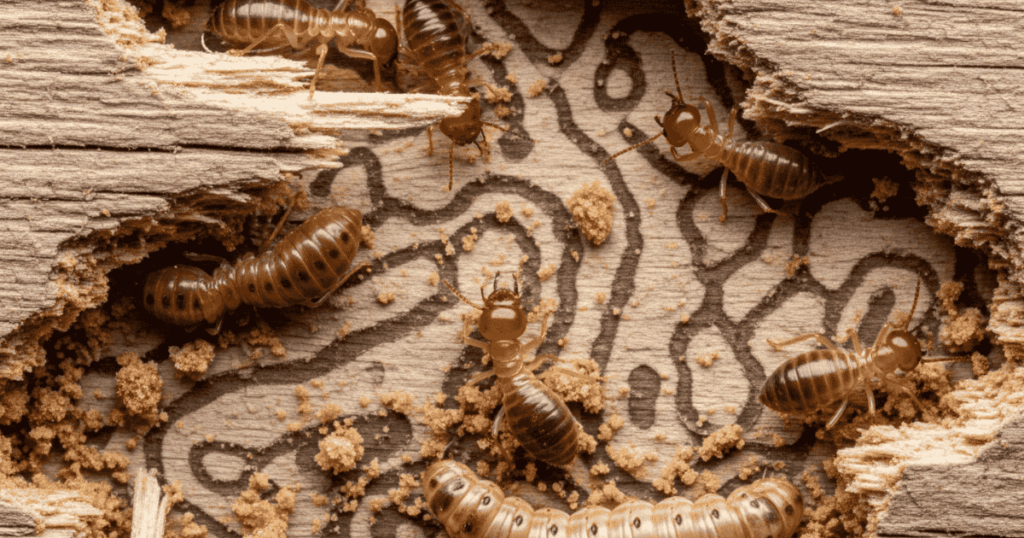
Once you’ve mastered how to get rid of wood eating insects, focus on prevention to ensure long-term safety of structures and furniture.
Prevent moisture and humidity buildup
Most wood eating insects, especially termites, powderpost beetles, and wood mites, prefer damp environments. Install dehumidifiers in basements and attics and repair leaks promptly. Learning how to get rid of wood eating insects starts with drying wood and controlling indoor humidity to deter egg-laying and larval growth.
Seal cracks, crevices, and entry points
Use caulk, wood filler, or pesticide-sealant products on joints, gaps, and splits. Prevents both entry and re-emergence of insects, even wood-boring bees. A tight building envelope supports how to get rid of wood eating insects by removing access routes and sealing egg-laying sites on unfinished wood.
Inspect and treat new wood
Before introducing wood products or structural timber, inspect for exit holes, powder, or larvae. Treat new wood with preventive borate solutions or sealants. This step cements how to get rid of wood eating insects by stopping hitchhikers from secondhand furniture, reclaimed boards, or firewood.
Regular cleaning and monitoring
Maintain a schedule for cleaning wooden furniture, flooring, and outdoor decks. Routine inspection can catch outbreaks before they become costly. Consistent checks, logs, and moisture readings reinforce how to get rid of wood eating insects and keep future infestations from spreading.
Prevention Checklist
| Prevention Step | Materials Needed | Frequency |
| Dehumidify rooms | Dehumidifier | Weekly |
| Seal wood surfaces | Caulk, wood filler, sealant | Bi-annual |
| Inspect new wood | Torch, magnifier | Upon arrival |
| Clean wood thoroughly | Vacuum, steam cleaner | Monthly |
| Professional inspection | Pest control contact | Yearly |
| Repair leaks immediately | Plumbing tools/additional wood | As-needed |
Treating Specific Wood Eating Insect Infestations
Customize your response based on which insects you’re facing. Here are in-depth solutions for major types:
How to Get Rid of Termites?
- Identify mud tubes, hollow wood, and stains.
- Use professional fumigation or liquid termiticide barriers around the foundation.
- Regularly treat ground-contact wood with borate solutions.
- Remove wood debris and stumps near buildings; avoid wood-to-soil contact.
How to Get Rid of Carpenter Ants?
- Locate frass and smooth tunnels in moist wood.
- Apply ant baits with slow-acting toxins.
- Remove decaying wood and replace it with treated timber.
- Dry out damp areas to discourage nesting.
How to Get Rid of Powderpost Beetles?
- Find fine powder, small exit holes, and faded furniture.
- Apply injection chemistry and sealers to deep tunnels.
- Heat-treat infested wood where feasible.
- Store hardwoods in dry, well-ventilated spaces.
How to Get Rid of Carpenter Bees?
- Inspect for round entry holes and yellow stains.
- Fill and seal holes after treating with insecticide dust.
- Paint or varnish exposed wood, as carpenter bees dislike treated surfaces.
How to Get Rid of Wood Mites?
- Identify mites visually or via fine dust.
- Mix apple cider vinegar, borax, and hot water for frequent spray treatment.
- Reduce indoor humidity and remove any mold.
- Vacuum affected areas meticulously.
Insect-Specific Treatments
| Pest | Key Signs | Top Treatment | Prevention Tip |
| Termites | Mud tubes | Fumigation, barriers | Remove wood–soil contact |
| Carpenter Ants | Frass, tunnels | Ant baits, dry timber | Fix leaks, dehumidify |
| Powderpost Beetles | Fine powder, holes | Borate injection, heat | Dry and inspect wood |
| Carpenter Bees | Round holes | Insecticide, wood seal | Paint/varnish exposed |
| Wood Mites | Visible dust | Vinegar-borax spray | Lower humidity, clean |
Professional Pest Control for Wood Eating Insects
Sometimes DIY solutions aren’t enough; professional help can save money and time. Here’s when to call a specialist:
- Severe and widespread infestations, especially termites or powderpost beetles.
- Signs of structural risk (weak beams, loose floorboards).
- Complex pest life cycles (eggs inside furniture, hidden galleries).
- Recurrent infestations after DIY treatments.
Seek certified, experienced pest control companies with proven track records in how to get rid of wood eating insects. Confirm that chemicals used are approved for residential safety and request detailed inspection reports.
For comprehensive and hassle-free Wood Eating Insects removal and long-term pest prevention, trust the professionals at Antipest Office. Visit us at the Antipest Office, Our trained technicians use safe and effective methods to protect your home and business. For service bookings and consultations, call us at +91 9819018398 .
Restoration After Infestation
After you succeed in how to get rid of wood eating insects, it’s time to restore damaged wood and prevent relapses.
- Fill and seal tunnels with wood fillers or epoxy resin.
- Sand and repaint or refinish affected surfaces.
- Replace severely compromised wood beams, flooring, or furniture legs.
- Maintain vigilance, reinspect treated areas for signs of recurring pests.
Restoration Steps and Materials
| Restoration Task | Recommended Materials | Purpose |
| Fill tunnels and holes | Wood filler, epoxy resin | Structural repair |
| Sand and refinish | Sandpaper, stains, varnish | Aesthetic improvement |
| Replace compromised timber | Treated wood, screws | Safety and longevity |
| Reinspect regularly | Torch, magnifier | Prevent recurrence |
Common mistakes that keep pests coming back
Avoiding these errors can save weeks of effort and prevent repeat damage.
- Treating finished wood without opening access for penetration.
- Skipping moisture fixes before or after chemical treatments.
- Misidentifying the pest and choosing the wrong tactic.
- Moving infested items indoors or between rooms without containment.
- Ending monitoring after one “quiet” month; some beetles emerge seasonally.
Conclusion
Learning how to get rid of wood eating insects is both a proactive and essential strategy for anyone looking to maintain the integrity and value of wood within their home or business. By focusing on early identification, targeted solutions, such as moisture control, borate treatments, and careful sealing, and ongoing monitoring, it’s possible to keep your environment safe and avoid costly repairs.
Understanding how to get rid of wood eating insects means consistently applying preventive habits, making informed choices between DIY and professional methods, and restoring damaged wood with diligence. When you master how to get rid of wood eating insects, you not only protect your property but also create long-term peace of mind, knowing that your wood investments will stand strong for years to come.
How to Get Rid of Wood Eating Insects? – FAQs
How to get rid of wood eating insects in furniture fast?
Confirm active frass or exit holes, isolate the piece, apply borate to bare wood, and use heat or freezing for small items; seal surfaces after treatment.
How to get rid of wood eating insects in hardwood floors?
Verify active beetle emergence or termite signs, reduce moisture, treat exposed areas with borate, replace severely compromised boards, and refinish to seal pores.
How to get rid of wood eating insects in structural beams?
Get a professional inspection, correct leaks and humidity, inject insecticide into galleries, consider fumigation for widespread activity, and reinforce or replace damaged sections.
How to get rid of wood eating insects without damaging antiques?
Use controlled freezing for small items, avoid harsh heat or solvents, consider professional micro-injection, and apply reversible conservation-grade sealers afterward.
How to get rid of wood eating insects using DIY methods?
Combine moisture control, borate on stripped wood, targeted heat/freezing for small items, disposal of unsalvageable pieces, and post-treatment sealing to prevent re-entry.
How to get rid of wood eating insects in a humid basement?
Fix leaks, add dehumidifiers and ventilation, remove damp or rotting wood, apply borate to accessible lumber, and monitor for new frass or emergence seasonally.
How to get rid of wood eating insects vs calling professionals?
Use DIY for small, accessible items; call professionals for structural, hidden, or multi-room cases requiring injection, fumigation, or certified applications.
How to get rid of wood eating insects in reclaimed timber?
Quarantine incoming wood, kiln-dry or heat-treat if possible, apply borate to all faces, store elevated and dry, then seal surfaces before interior use.
How to get rid of wood eating insects and prevent reinfestation?
Seal finishes, control humidity, inspect secondhand items, store firewood outdoors, maintain drainage, and schedule seasonal checks for frass and exit holes.
How to get rid of wood eating insects economically?
Prioritize moisture fixes, apply borate to bare wood, use heat/freezing for small items, replace only severely damaged sections, and reserve pros for complex cases.

